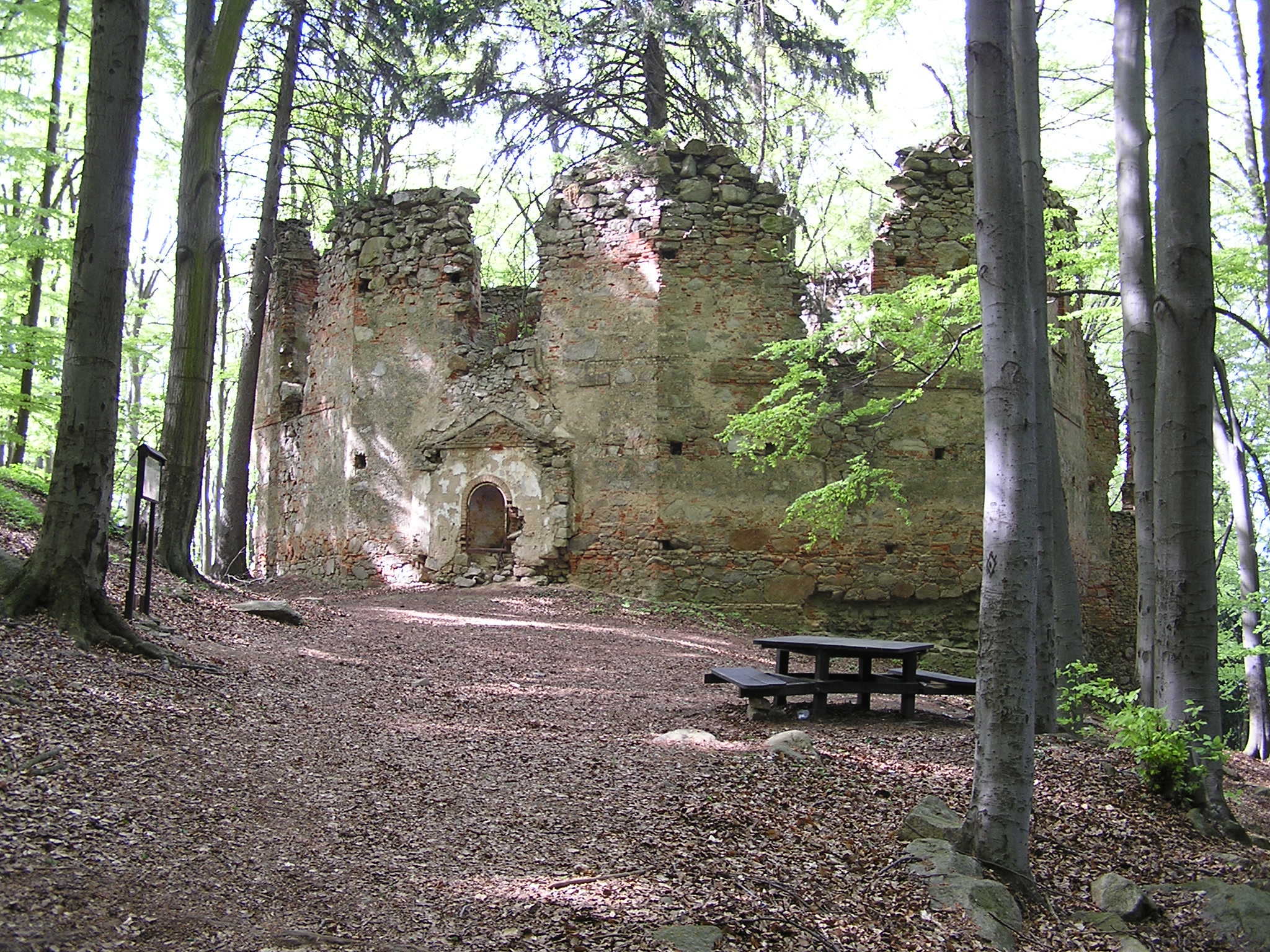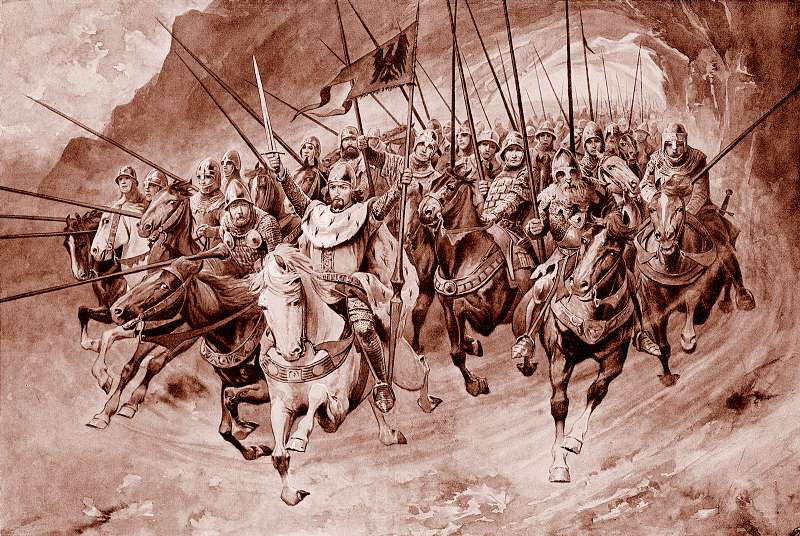Blaník on:
[Wikipedia]
[Google]
[Amazon]
Blaník (Czech: ) is a mountain in the

 In the 5th century BC, during the
In the 5th century BC, during the
 Blaník is surrounded by many
Blaník is surrounded by many
Natural reservation Blaník (in English)
{{DEFAULTSORT:Blanik Mountains and hills of the Czech Republic King asleep in mountain Benešov District
Czech Republic
The Czech Republic, or simply Czechia, is a landlocked country in Central Europe. Historically known as Bohemia, it is bordered by Austria to the south, Germany to the west, Poland to the northeast, and Slovakia to the southeast. The ...
near Louňovice pod Blaníkem
Louňovice pod Blaníkem (german: Launiowitz) is a market town in Benešov District in the Central Bohemian Region of the Czech Republic. It has about 700 inhabitants.
Administrative parts
Villages of Býkovice, Mrkvová Lhota, Rejkovice and Svět ...
. The hill and surrounding area is a nature reserve
A nature reserve (also known as a wildlife refuge, wildlife sanctuary, biosphere reserve or bioreserve, natural or nature preserve, or nature conservation area) is a protected area of importance for flora, fauna, or features of geological or ...
. The Blaník massif consists of two forested rocky hills, Great Blaník (638 m) and Small Blaník (580 m).
The mountain has played an important role in Czech national mythology since the Middle Ages (together with the mountains Říp and Radhošť
Radhošť () is a mountain in the Czech Republic. It has an elevation of and belongs to the Moravian-Silesian Beskids mountain range. It is located in Dolní Bečva and Trojanovice municipalities in the Zlín and Moravian-Silesian regions, w ...
); therefore, during the era of the Czech National Revival
The Czech National Revival was a cultural movement which took place in the Czech lands during the 18th and 19th centuries. The purpose of this movement was to revive the Czech language, culture and national identity. The most prominent figures o ...
, a stone quarried from Blaník was symbolically placed in the foundations of the newly built National Theatre in Prague
Prague ( ; cs, Praha ; german: Prag, ; la, Praga) is the capital and largest city in the Czech Republic, and the historical capital of Bohemia. On the Vltava river, Prague is home to about 1.3 million people. The city has a temperate ...
.
Buildings

 In the 5th century BC, during the
In the 5th century BC, during the Hallstatt period
The Hallstatt culture was the predominant Western Europe, Western and Central European Archaeological culture, culture of Late Bronze Age Europe, Bronze Age (Hallstatt A, Hallstatt B) from the 12th to 8th centuries BC and Early Iron Age Europe ...
, a circular hillfort
A hillfort is a type of earthwork used as a fortified refuge or defended settlement, located to exploit a rise in elevation for defensive advantage. They are typically European and of the Bronze Age or Iron Age. Some were used in the post-Roma ...
with two rows of massive stone walls was built at the top of Great Blaník; its remnants are still visible around the summit. Later, a fortress and probably a wooden castle were built there.
At the top of Great Blaník stands a 30 m tall wooden watchtower
A watchtower or watch tower is a type of fortification used in many parts of the world. It differs from a regular tower in that its primary use is military and from a turret in that it is usually a freestanding structure. Its main purpose is to ...
from 1941 in the shape of a Hussite
The Hussites ( cs, Husité or ''Kališníci''; "Chalice People") were a Czech proto-Protestant Christian movement that followed the teachings of reformer Jan Hus, who became the best known representative of the Bohemian Reformation.
The Hussit ...
tower. On the top of Small Blaník are the ruins of the pilgrimage Chapel of St. Mary Magdalene
Mary Magdalene (sometimes called Mary of Magdala, or simply the Magdalene or the Madeleine) was a woman who, according to the four canonical gospels, traveled with Jesus as one of his followers and was a witness to crucifixion of Jesus, his cru ...
. Its construction was completed in 1753 but it was abolished in 1783 by a decree of the Emperor Joseph II
Joseph II (German: Josef Benedikt Anton Michael Adam; English: ''Joseph Benedict Anthony Michael Adam''; 13 March 1741 – 20 February 1790) was Holy Roman Emperor from August 1765 and sole ruler of the Habsburg lands from November 29, 1780 unt ...
. The ground plan of the chapel is formed by an octagon composed into an ellipse, under which there used to be a hermit cave. In the middle of the ruins grows a 160-year-old spruce
A spruce is a tree of the genus ''Picea'' (), a genus of about 35 species of coniferous evergreen trees in the family Pinaceae, found in the northern temperate and boreal (taiga) regions of the Earth. ''Picea'' is the sole genus in the subfami ...
called "Big Monk."
In popular culture
Czech historical novelistAlois Jirásek
Alois Jirásek () (23 August 1851, Hronov, Kingdom of Bohemia – 12 March 1930, Prague) was a Czech writer, author of historical novels and plays. Jirásek was a high school history teacher in Litomyšl and later in Prague until his retirement in ...
portrayed the Blaník legend in his ''Ancient Bohemian Legends
''Ancient Bohemian legends'' (''Staré pověsti české'' in Czech) is a book by Alois Jirásek written in 1894. It describes events from Czech history based on folk literature and some historical facts. The model was based on Chronicle of Háje ...
''.
The last movement of Smetana’s symphonic poem ''Má vlast
''Má vlast'' (), also known as ''My Fatherland'', is a set of six symphonic poems composed between 1874 and 1879 by the Czech composer Bedřich Smetana. The six pieces, conceived as individual works, are often presented and recorded as a single ...
'' is called ''Blaník''.
The Czechoslovak-built Let L-13
Let or LET may refer to:
Sports
* Let serve, when the served object in certain racket sports hits the net and lands in the correct service court, such as;
** Let (badminton)
** Let (pickleball)
** Let (tennis)
* Ladies European Tour, the ladi ...
sailplane is called the Blaník after the mountain, and the Let L-23
Let or LET may refer to:
Sports
* Let serve, when the served object in certain racket sports hits the net and lands in the correct service court, such as;
** Let (badminton)
** Let (pickleball)
** Let (tennis)
* Ladies European Tour, the ladi ...
is called the Super Blaník.
Legend
 Blaník is surrounded by many
Blaník is surrounded by many legend
A legend is a Folklore genre, genre of folklore that consists of a narrative featuring human actions, believed or perceived, both by teller and listeners, to have taken place in human history. Narratives in this genre may demonstrate human valu ...
s, some of which probably originate in Celtic
Celtic, Celtics or Keltic may refer to:
Language and ethnicity
*pertaining to Celts, a collection of Indo-European peoples in Europe and Anatolia
**Celts (modern)
*Celtic languages
**Proto-Celtic language
* Celtic music
*Celtic nations
Sports Fo ...
times. The main legend about knight
A knight is a person granted an honorary title of knighthood by a head of state (including the Pope) or representative for service to the monarch, the church or the country, especially in a military capacity. Knighthood finds origins in the Gr ...
s arose probably in the 15th century
The 15th century was the century which spans the Julian dates from 1 January 1401 ( MCDI) to 31 December 1500 ( MD).
In Europe, the 15th century includes parts of the Late Middle Ages, the Early Renaissance, and the early modern period.
M ...
among the common people on the basis of an event, when the enemy army was defeated in a miraculous way at the southeastern foothill of Blaník, near the village of Býkovice.
The legend says, that there is an army resting inside the mountain and waiting for the Czech nation to be at its worst. Its commander is the patron saint
A patron saint, patroness saint, patron hallow or heavenly protector is a saint who in Catholicism, Anglicanism, or Eastern Orthodoxy is regarded as the heavenly advocate of a nation, place, craft, activity, class, clan, family, or perso ...
of the country St. Wenceslaus. It is said that a day inside the mountain is as long as a year on the surface. As soon as the Czech country will be in its deepest distress, a rock shall open up in the mountain, the knights inside wake up from a deep sleep, and will set off against the enemies. They will defeat them, and peace and tranquility will come back to Bohemia
Bohemia ( ; cs, Čechy ; ; hsb, Čěska; szl, Czechy) is the westernmost and largest historical region of the Czech Republic. Bohemia can also refer to a wider area consisting of the historical Lands of the Bohemian Crown ruled by the Bohem ...
.
Since 1989, St. Wenceslaus Celebrations have been regularly held here. From the Great Blaník Wenceslaus is accompanied by his soldiers and comes on a white horse to Louňovice pod Blaníkem
Louňovice pod Blaníkem (german: Launiowitz) is a market town in Benešov District in the Central Bohemian Region of the Czech Republic. It has about 700 inhabitants.
Administrative parts
Villages of Býkovice, Mrkvová Lhota, Rejkovice and Svět ...
square, where the celebrations are held.
At Rudka (a part of Kunštát
Kunštát (; german: Kunstadt) is a town in Blansko District in the South Moravian Region of the Czech Republic. It has about 2,800 inhabitants.
Administrative parts
Villages of Hluboké u Kunštátu, Rudka, Sychotín, Touboř and Újezd are ad ...
) a sandstone
Sandstone is a clastic sedimentary rock composed mainly of sand-sized (0.0625 to 2 mm) silicate grains. Sandstones comprise about 20–25% of all sedimentary rocks.
Most sandstone is composed of quartz or feldspar (both silicates) ...
man-made cave with carved figures of the Blaník knights is located. It is a popular touristic attraction.
See also
*King asleep in mountain
The king asleep in mountain (D 1960.2 in Stith Thompson's motif index system) is a prominent folklore trope found in many folktales and legends. Thompson termed it as the Kyffhäuser type. Some other designations are: king in the mountain, king ...
External links
Natural reservation Blaník (in English)
{{DEFAULTSORT:Blanik Mountains and hills of the Czech Republic King asleep in mountain Benešov District